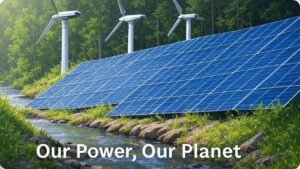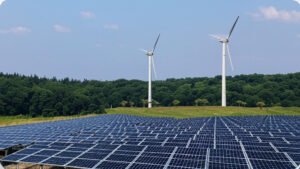Earth Day 2025: Embracing Our Power, Our Planet Theme
Introduction
Earth Day 2025 will be celebrated on April 22, 2025, and brings the world together with the theme “Our Power, Our planet”. This theme focuses on increasing global renewable energy use threefold by 2030 for climate change mitigation and sustainable development. As the largest green movement, Earth Day brings together more than 1 billion people from 190 countries. It is the most important platform for action. The current article focuses on the 2025 theme, the history of Earth Day, steps available for citizens and communities, the global significance of the event, and technology’s contribution towards an increase in renewable energy. From all these insights, we know that we can make great contributions to a greener planet.

History and Evolution of Earth Day
On April 22nd of every year, Earth Day is celebrated, and it traces its history back to 1970 when US senator Gaylord Nelson spearheaded it. Nelson was inspired by anti-war protests of the 1960s and after Rachel Carson raised concerns about pesticide issues in her 1962 book Silent Spring, Nelson organized a ‘national teach-in’ to promote environmental awareness. The first Earth Day had 20 million Americans, which was 10% of the population of the US at that time, participating in rallies, marches, and educational programs. This led to the creation of the Environmental Protection Agency (EPA), along with landmark laws like the Clean Air Act, Clean Water Act, and Endangered Species Act (EPA History).

Internationally noted since 1990, Earth Day is currently celebrated in 141 countries worldwide, while 200 million individuals participated in 1990. It was Denis Hayes who coordinated the celebrations. 2016 marked the signing of the Paris agreement by 195 nations, a major milestone in climate treaties (Wikipedia). Today, Earth Day is the largest secular observance in the world, with participation exceeding over a billion people annually. To further this effort, the theme for 2025 is set to be Our Power, Our Planet, focusing on renewables to combat climate issues.
The Theme For Earth Day 2025: Our Power, Our Planet
The theme for 2025, “Our Power, Our Planet”, as put forth by EarthDay.org, calls on the world to ramp up clean electricity generation threefold by 2030. It emphasizes the need to harness renewable sources such as solar, wind, hydroelctric, geothermal, and tidal energy in a bid to reduce dependence on fossil fuels. Achieving this target is essential in the global efforts to control the increase in temperature to 1.5°C and safeguard ecosystems and biodiversity.

Why Is Renewable Energy Important
Renewable energy has a range of advantages including but not limited to:
Protection of the Environment: There is a renewables source of energy produces the least amount of greenhouse gases which protects the environment and prevents global warming, air pollution and climate change.
Employment: The renewable energy sector has seen job opportunities emerging. In 2023, there were over three million jobs in the solar industry and this number is projected to grow by 2030 (Deloitte Insights).
Energy Independence: The greater the reliance on renewable resources, the lower dependency there is on imported fuels.
Sustainability: Unlike fossil fuel resources, renewable sources of energy are considered inexhaustible.
Progress and Challenges in 2025
In 2024, IRENA reported reaching a renewable capacity of 4448 gigawatts (GW), having added 585 GW, corresponding to a growth rate of 15.1% (IRENA Statistics). The International Energy Agency (IEA) anticipates renewables will overtake coal fire generation in 2025, with solar photovoltaics (PV) expected to be the largest contributor by 2029 (IEA Renewables). By 2030, renewables may constitute 46% of global electricity, with solar and wind accounting for 30%. However, making the tripling target requires an annual capacity increase of 16.6%, which is constrained by geographic disparities and policy issues.
| Renewable Energy Milestones | Year | Description |
|---|---|---|
| Renewables exceed coal | 2025 | Renewable electricity exceeds coal-fired generation. |
| Solar PV surpasses wind | 2027 | Leading renewable source shifts to Solar PV. |
| Solar PV surpasses hydropower | 2029 | Solar PV becomes the dominant renewable power source. |
| Renewables reach 46% globally | 2030 | Wind and solar supply 30% of global electricity. |
Specific Actions and Case Studies
Everyone can contribute to the “Our Power, Our Planet” goal. People are able to take action by installing solar panels, participating in community solar projects, or selecting green energy options through their utility providers. For instance, community solar gives renters the opportunity to invest in solar arrays, increasing access to renewables (EarthDay.org Activities).
Communities can show the way. Iowans can take pride in their accomplishments, as the City has achieved a 45% reduction in emissions before 2030 (on Earth Action Day) by installing solar panels on public structures, including the Bike Library, and adding electric vehicles to the fleet, including a state-of-the-art patrol-rated EV. Solar co-ops are another example that enable group purchases of solar panels at discounted rates.

Renewable Energy Certificates (RECs) or systems installed on-site can be purchased by businesses, while tax incentives and the removal of fossil fuel subsidies can be provided by the government. Spending on renewable technologies could create 14 million jobs worldwide (Energy Saving Trust).
Worldwide Significance of Earth Day
Environmental policies and concerns have been supported by Earth Day since the early 1970s. Earth Day launched the formation of the EPA and environmental laws within the US, in addition, it facilitated the signing of the Paris Agreement on Earth Day 2016. With more than a billion people participating in Earth Day, the event’s scope—the figure claimed—changes the world’s perception regarding climate change, pollution, and deforestation (history.com).

The 2025 theme coincides with global trends in new renewables. IRENA has stated that 2024 saw 92.5% of new capacity from renewables in Central America, although the pace of development remains slow (IRENA Press Release). Advocacy on behalf of Earth Day moves the needle toward equitable access to renewable energy.
Renewable Energy Technology and Innovations
The rapid development of technologies directly impacts the growth rate of renewable energy. For example, the cost of solar PV fell by 93% from 2010 to 2020 (Energy Saving Trust). Wind turbines are more powerful and larger, battery storage resolves the problem of renewables’ intermittency and AI optimizes energy systems by forecasting weather, grid management, and operational efficiency (Deloitte Insights). Advancements in materials science are aiding in enhancing the solar cell efficiency and durability of wind turbines for the target of tripling the renewables by 2030.

A Call to Action
Take part in Earth Day 2025 by taking action now. Sign a petition to triple the renewables by 2030, plant trees via the Canopy Project, or participate in local activities (EarthDay.org Petition). Educators can foster lessons on sustainability, businesses can transition to renewables, and governments can implement favorable policies. Share your activities with the people on X using #EarthDay2025 and #OurPowerOurPlanet so others would be motivated. In reality, every step, no matter how small, is integral for a sustainable future.
Conclusion
The celebration of Earth Day 2025 also serves as an opportunity to develop renewables and fight climate change on global scale because the theme for that year is “Our Power, Our Planet.” As we have seen in the past, specific actions taken towards has regions of concern leads to technology development and recognition, eventually leading towards sustainable greener earth. Make sure we work together towards April 22, 2025 with a goal of turning point for sustainable efforts. Engage every day of the year through EarthDay.org in order to truly make it a day of celebration.



















Post Comment